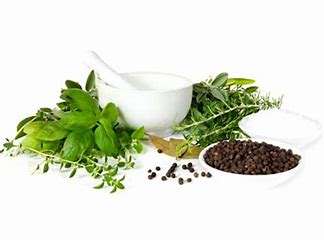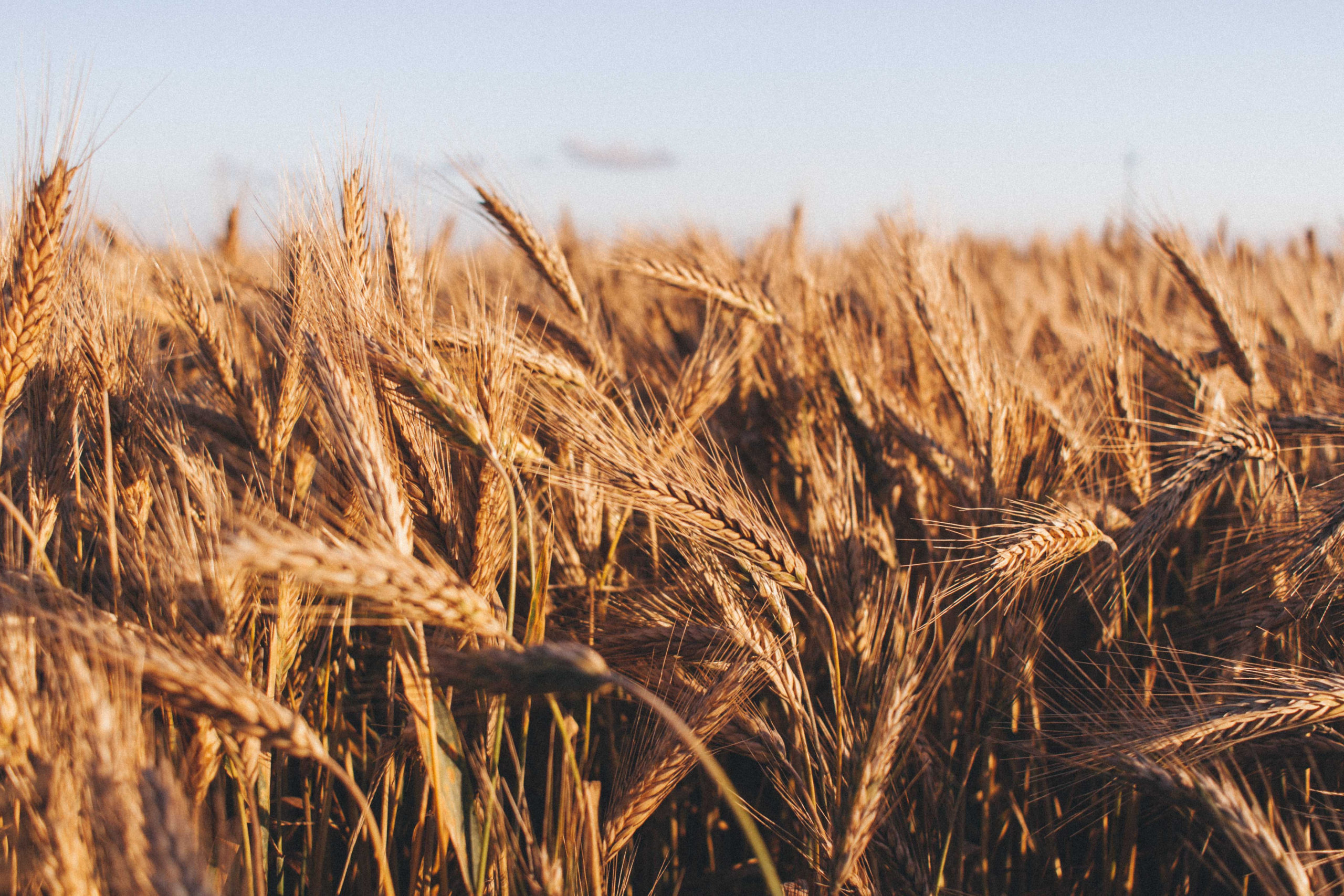Without herbs, I would probably not have the love for food that I do. Herbs are a balance between taste and health and as a dietitian and nutritionist, it is my duty to provide healthy, wholesome and tasty meal ideas that appeal not just to my clientele, but my family too! I am constantly searching for that extra little pop in food that not only ignites my taste buds, but also my nose. Herbs add flavor, color, texture and aromas that contribute to the full experience of eating a meal. Not only do herbs provide taste, but for thousands of years, herbs have been touted as medicinal foods to help protect our body against disease. Today, scientists are consistently discovering new and exciting ways in which herbs provide health benefits.
Health Benefits
The father of medicine, Hippocrates, stated thousands of years ago, “Let food be thy medicine and medicine be thy food”. After all of these years, this statement has stood the test of time. Research is consistently supporting the benefits of herbs and power of food that heals. The power of herbs and what contribute to the health of them lies in protective polyphenols. Polyphenols are plant compounds that naturally occur in plants to protect them from disease, toxins and bacteria. When we consume these compounds in plants, more specifically herbs, we get the same benefits. They provide powerful anti-oxidant and anti-inflammatory benefits. Studies show that the polyphenols in herbs help to combat disease from Alzheimer’s to diabetes to insomnia and chronic pain. In addition, polyphenols also help to protect against harmful bacteria, serving as herbal anti-microbials. Although these are typically found in concentrated amounts, eating and consuming herbs on the regular can contribute healthful benefits regardless of the amount.
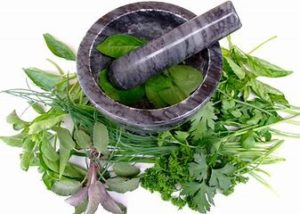
Powerful benefits of Herbs include:
- Anti-microbial
- Adaptogens (helps body to adapt to stress and balances hormones)
- Aid digestion
- Help with detox
- Boost immunity
- Promotes healthy skin
- Reduces inflammation
Cooking with Herbs
Cooking with herbs is easy. Fresh herbs are my preference, but not always available. Depending on your climate, you can have the luxury of enjoying a variety of fresh herbs all year round in your own garden. Dry herbs are also very powerful and add a different level of flavor. Below are some of my top picks for growing and cooking with herbs.
- Basil: has a spicy aroma and flavor of pepper, clove, mint and licorice. Very little needed for flavor. Add to finish a dish or add to sauces, pesto, potatoes, salads and rice dishes. Benefits: Antimicrobial, powerful adaptogen, antioxidant
- Mint: is very hardy and fragrant. Best used fresh in soups, stews, stuffing and salads. Delicious with carrots, potatoes, eggplant, beans, grilled fish and lamb. Benefits: aids digestion, palate cleanser
- Thyme: Essential in Western and Middle Eastern cooking. It is very earthy with a taste of clove and mint. Is very tasty fresh or dried. Wonderful in slow cooked recipes like stews and slow cooked meals. Combines well with garlic, onion, red wine, basil, lavender and parsley. Use in tomato and wine based sauces, soups, marinades for pork and poultry as well as mushrooms, leeks and eggplant. Benefits: anti-bacterial, fights sore throat, digestive health, anti-diarrheal, boosts immune system
- Parsley: Found either curly or flat, parsley is fresh and spicy with a hint of pepper. Stems are even more flavorful than the leaves. Great for broths and stocks, salads, tabbouleh, fish and omelets. Benefits: aids digestion, decrease bloating, boost immunity, detox and kidney health
- Oregano: Zesty and strong flavors, close member of the mint family. Typically used in a lot of Italian dishes, but can be used in a wide variety of cuisines including Mexican. Delicious in tomato sauces, breads, pastas, soups, meat dishes, roasted veggies (eggplant, zucchini, tomatoes), dressings for salads, marinades and pizza. It is a lovely herb and makes a great addition to any spice blend. Benefits: Antimicrobial, boosts immune system, aids digestion, antioxidant
- Cilantro: Earthy with a parsley, mint and lemon characteristic. Pairs well with almost any savory food or light and fresh cuisine. Great in chutneys and salsas. Pairs well with fish, seafood, beans, plantains, root vegetables and squash. It is best to add fresh at the end of cooking. Benefits: detox-helps rid body of toxic metals, aids digestion, helps with sleep
- Rosemary: Smells and tastes like lavender and nutmeg. Combines well with thyme, bay leaves, garlic and wine. Best when used fresh. Pairs well with pork, lamb, poultry, zucchini, potatoes and tomatoes. Benefits: boost memory, decrease inflammation, healthy skin, fights bacterial infections
- Sage: is referred to as the herb of longevity. Has a pleasantly pungent lemony flavor and makes a great addition to soups, breads, stuffing, sauces and pasta dishes. Part of the mint family and is great fresh or dried. Benefits: aids digestion, helps decrease heartburn
- Dill: If I had to choose my favorite, it would probably be dill. Dill adds an incredible punch of flavor to fish, salads, soups and veggies. Dill is a cousin of celery, but has a much stronger flavor and is very aromatic. It is typically used in Eastern European cuisine and Central Asia. Benefits: Aids digestion, prevents gas and boosts immune system.
- Ginger: A spicy, fragrant spice used in many ways. As a delicacy, medicinally or as a spice. Is a quintessential ingredient in Asian cooking, but also can be used in baking. Pairs well with stir-fry, marinades, vegetables and dressings. Benefits: aids digestion, decrease inflammation and nausea
- Turmeric: This is one of the most powerful anti-inflammatory spices we can consume. Turmeric is mildly aromatic with scents of orange and ginger. Can buy in powder form or whole. The flavor is pungent, bitter and warm. It is used to add color and flavor to mustard . A great addition to soups, eggs, spice blends, curries, dressings and marinades. Used often as a supplement to reduce inflammation. Benefits: Anti-inflammatory, supports digestion, improves liver function, relieves pain.
Growing Herbs
There is nothing better, in my opinion, than using fresh herbs for cooking. And what makes it even better is using my own! Growing your own herb garden is easy and also cost-effective. How often do you buy fresh herbs and they spoil before you can use them?? Not to mention, the best health benefits are when you eat plants, fruits and vegetables immediately after harvesting. Therefore, snipping what I need and leaving the rest is a double win.
For more tips on growing and maintaining herbs, I turned to the gardening Guru himself, Doug Oster from Gardening with Doug in Pittsburgh, PA. Doug is the king of gardening and has amazing tips and incredibly useful information on the Do’s and Don’ts of all your gardening needs. When it comes to growing herbs, is it better to grow in pots or in the ground? According to Doug, he states “herbs are adaptable and would grow both places equally well.” He continues to say “I like making a big container filled with herbs and put right outside the kitchen.” This enables you to grab what you need, when you need it without going far!
Let’s Talk Soil
Before we get to how to plant your own herb garden, let’s talk soil. “The best thing any gardener can do when growing herbs outdoors is to improve the soil with compost,” states Oster. “You can make your own, can buy by the bag or get a truckload from a local nursery,” he continues on. Composting is not only good for your plants, but it can be easy, free and good for the environment. Composting offers a natural alternative to chemical fertilizers since “compost gives the plants everything they need, when they have it, they will outgrow most pests and diseases”, says Oster. If you choose not to compost or pest/insects are persistent, then it is recommended by our guru to identify the problem. If the plant is being attacked by a chewing insect, then he recommends using a safe organic way to deal with the problem. Doug recommends Captain Jack’s Deadbug Brew. For sucking insects like aphids, spider mites, and others, he recommends simply using a strong stream of water from a hose to knock them off the plant. Finally, he states “insecticidal soaps and horticultural oils are also safe and organic ways to protect your plant and deal with pests.”
Ground vs. Pot
As mentioned above, planting in the ground or pot are both great methods for having an herb garden. Mint should ideally be contained because if not, it will grow like a weed and will be very difficult to get rid of!
Ground
Before planting in the ground, Doug recommends putting the compost down right in the garden bed and planting directly in the compost then in the mulch. According to Doug, mulch should never touch the base of the plant and should be applied to look more like a doughnut rather than a volcano. Over mulching or creating more of a volcano with your plant can contribute to the decline of the herb or plant by trapping excess moisture, which may cause pre-mature death of your plant. Therefore, save money on mulch and use the doughnut mulch method to plant your herbs! The herb or plant will sit nicely in the hole of the doughnut.
Pot
For planting in pots, he recommends getting a good planting mix, get it moist and then add it to the pot before planting your herbs. When it is time to plant, Doug’s methodical method of organizing the placement of each herb involves the words: Thriller, Filler and Spiller. Tall plants go in the center and shorter around the edges. A Thriller herb might be a big basil plant in the middle, then surrounded by fillers of sage, cilantro or parsley followed by spillers like oregano or mint (something that will fall along the outside of the pot). Great tip! This not only makes for a delicious addition to our meals, but also the aromas you get as you pass by your pot or garden and the beautiful art piece before your eyes. For mint, make sure you cover the draining holes, per Doug, as the roots will find their way into the ground or garden!
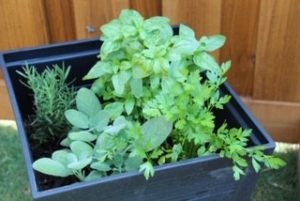
New Varietal
If looking to add a new flare to your garden this year, Doug recommends experimenting with ‘Everleaf Emerland Towers’, a new type of basil entering the garden centers. It’s leaves are large and robust and has the added benefit of not having to worry about the plant flowering, which ultimately leads the leaves to become bitter. Basil is his favorite herb to cook with and says that this new varietal is not only amazing to eat, but an added benefit is that it is resistant to basil downy mildew, a common fungal disease. This varietal does very well in a pot!

Buying and Storing
If planting is not an option or the weather does not permit, you can generally find almost any herb available at your local market. If you choose this route, herbs can potentially last up to 2-3 weeks if properly handled. Ideally, try to find organic herbs and rinse when you get home. Let them dry well on a towel or you can spin with a salad spinner. Be mindful of whether you are dealing with tender stems (cilantro, basil, dill) or hard stems (rosemary, oregano, thyme). Hard stems will last much longer.
Tender Stems
For herbs like cilantro, dill and parsley, remove from bags and remove any bands that are holding them together. Dampen a paper towel and loosely wrap the herbs in the towel. You can then place in a plastic bag or plastic wrap. Or you can use a big mason jar and place the herbs in the jar. Store in the fridge until ready to use. For basil, I typically keep in a jar on my counter with water. Leave uncovered next to some sunlight and use as you cook. I find that basil this way can last for quite some time. I may need to change the water a few times, but it freshens up the kitchen and of course smells wonderful!
Hard Stems
As for the hardy herbs like rosemary, thyme and oregano. These will last for up to 2 weeks. Use the same method of rolling the herbs up in a damp paper towel then cover or put in a large plastic bag or mason jar and place in fridge until ready to use. When the herbs start to brown or become brittle to the touch, they are most likely ready to toss. As for the tender herbs, toss when wilted and/or brown.
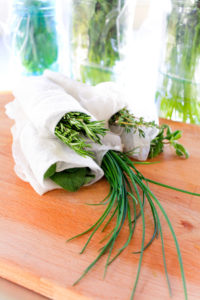
Herbing up
If your mouth isn’t watering yet, then now is the time. Below are some helpful tips to include herbs into cooking and preparing food. Most fresh herbs are best added right at the end of the cooking process for the best flavor and aroma. Spices are typically best used while cooking. Below are some of my favorite ways to “herb up”:
- Add fresh chopped basil or mint to a mixed green salad right before serving
- Grilled watermelon with fresh mint and goat cheese
- Finely chopped parsley with quinoa, tomatoes, cucumber and lemon juice–Quinoa Tabbouleh!
- Add fresh basil to homemade pasta sauce, pizzas or soups right before serving
- Try Chimichurri! Combine fresh cilantro, mint and basil in a blender with garlic, olive oil and vinegar for a tasty spread or dip
- Use fresh thyme in home made dressings
- Freshly grated ginger is delicious when added to stir-fry’s, soups, dressings, roasted veggies and smoothies!
- Use dried sage in spice blends and rubs for chicken or turkey or pan fry leaves in a small amount of olive oil, allow to cool and serve whole or sprinkle on top of soups, rice or pasta dishes. Sage pairs nicely with butternut squash soup!
- Fresh snipped rosemary adds a lot of flavor when added to dishes while they are cooking. A sprig of rosemary on top of or stuffed in a chicken while roasting or added to soups and broths are a great way to boost flavors and aromas
- Enjoy fresh chopped dill over salmon or with a classic cucumber and tomato salad
- Add parsley to a green smoothie!
A final note
Herbs not only provide taste, aroma or color to your dish, but including herbs in your diet provides so many healthful benefits. Eating more is an easy way to reduce inflammation, boost your immune system and help support the gut. We encourage you to experiment weekly or even daily with herbs! Whether you are buying or growing yourself, it can be a fun activity to do alone or with the family.
If I haven’t convinced you yet on growing your own herb garden or cooking with herbs, then take a little advice from Doug Oster, “Gardening is Fun!”
For more information and to learn more about Doug Oster, visit his website at www.DougOster.com or follow him on Instagram or Facebook @dougoster and twitter @dougoster1.

